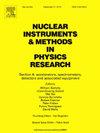On forced RF generation of CW magnetrons for accelerators
IF 1.5
3区 物理与天体物理
Q3 INSTRUMENTS & INSTRUMENTATION
Nuclear Instruments & Methods in Physics Research Section A-accelerators Spectrometers Detectors and Associated Equipment
Pub Date : 2024-10-18
DOI:10.1016/j.nima.2024.169977
引用次数: 0
Abstract
CW magnetrons, initially developed for industrial RF heaters, were suggested to power RF cavities of superconducting accelerators due to their higher efficiency and lower cost than traditionally used klystrons, IOTs or solid-state amplifiers. RF amplifiers driven by a master oscillator serve as coherent RF sources. CW magnetrons are regenerative RF generators with a huge regenerative gain. This causes regenerative instability with a quite large noise when a magnetron operates with the anode voltage above the threshold of self-excitation. Traditionally, an injection locking by a small signal is used for stabilization of magnetrons. In this case CW magnetrons with the injection-locked oscillations generate a high level of noise. This may preclude use of standard CW magnetrons in this operating mode in the Superconducting RF (SRF) accelerators. In this article we described a method developed for forced RF generation of CW magnetrons when the magnetron startup is provided by the injected forcing signal and the regenerative noise is suppressed. The method is most suitable for powering high Q-factor cavities.
关于用于加速器的强制射频产生的 CW 磁控管
连续波磁控管最初是为工业射频加热器开发的,由于其效率高、成本低,比传统使用的克里斯特伦、IOT 或固态放大器更适合为超导加速器的射频腔供电。由主振荡器驱动的射频放大器可用作相干射频源。连续波磁控管是一种再生射频发生器,具有巨大的再生增益。当磁控管在阳极电压高于自激阈值时工作,会产生再生不稳定性和相当大的噪声。传统上,小信号注入锁定用于稳定磁控管。在这种情况下,注入锁定振荡的 CW 磁控管会产生很大的噪声。这可能会妨碍在超导射频(SRF)加速器中使用这种工作模式的标准 CW 磁控管。在这篇文章中,我们介绍了一种用于强制射频产生 CW 磁控管的方法,当磁控管启动由注入的强制信号提供,再生噪声被抑制时,就会产生 CW 磁控管。这种方法最适合为高 Q 因子空腔供电。
本文章由计算机程序翻译,如有差异,请以英文原文为准。
求助全文
约1分钟内获得全文
求助全文
来源期刊
CiteScore
3.20
自引率
21.40%
发文量
787
审稿时长
1 months
期刊介绍:
Section A of Nuclear Instruments and Methods in Physics Research publishes papers on design, manufacturing and performance of scientific instruments with an emphasis on large scale facilities. This includes the development of particle accelerators, ion sources, beam transport systems and target arrangements as well as the use of secondary phenomena such as synchrotron radiation and free electron lasers. It also includes all types of instrumentation for the detection and spectrometry of radiations from high energy processes and nuclear decays, as well as instrumentation for experiments at nuclear reactors. Specialized electronics for nuclear and other types of spectrometry as well as computerization of measurements and control systems in this area also find their place in the A section.
Theoretical as well as experimental papers are accepted.

 求助内容:
求助内容: 应助结果提醒方式:
应助结果提醒方式:


